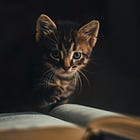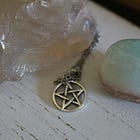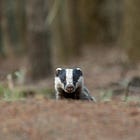Interview: Skeleton Ink
On death, connecting with nature, and reshaping narratives through art
Welcome to another Wizard of Claws interview!
Today we’ll be traveling to Aralland, a hidden realm draped atop our own. There, ghosts and vampires and other supernatural creatures roam, us mortal souls none the wiser. Our guide into this land is Skeleton Ink, who’s compiled a collection of journal entries by a recently deceased woman called Holly, giving us a peek into this mysterious land of the non-living.
All chapters in the ongoing series can be read for free here.
General Questions
Can you share a little bit about yourself, including how you came to care about animals and creative writing?
I was brought up by parents who taught me the importance of respecting living entities which were ‘other’ than human. We had animals in our house as I grew up, was taught about animal rights, wore t-shirts with slogans and illustrations my own mum had worn on marches and demonstrations and as a vegetarian was taught about why my eating habits differed from friends’ and classmates’ and the realities of slaughterhouses and farming animals for food. I wasn’t the most sociable person growing up and I would lose myself in books, reading at least two at once — but never getting the stories mixed up. This combined with my love of the outdoors and nature meant that the two were top hobbies of mine — rambling and cosying up with a good book.
Many of us have childhood dreams of becoming writers. When did you decide to give it a shot?
When I was younger, I would always answer that I wanted to be an author when I grew up, but my creative writing stalled a bit as a teenager, I think partly because of the prescriptive way it was taught in school (my school anyway). However, it started up again as I wrote bits of poetry and used words as an art form during my studies in textile and experience design at university. When I had a spine injury in 2024, I was very restricted as to what I could do, and my usual routine went out the window completely. So, I started to piece together snippets, conversations, notes and doodles I had made in the past and realised I could bring them together and start writing again.
Most animal advocacy focuses on creating tangible changes in the real world. What role can the arts play in changing how people think about animals?
I think the arts — be that visual arts, mixed media, creative writing — are a key part of engaging people with any theme or issue. Done in a creative way, campaigns or messages can reach people on a more emotional level than ‘just’ using facts and figures. Imagery and writing can evoke emotion and memories which catch people in their hearts and minds. So many people have a connection with a particular animal or species because of a childhood experience or reading a story which revolved around a particular animal character — so creating artistic ways to reach people throughout their life and keep them caring is a key part of change. I always say that knowledge, experience and understanding are the foundations of change.
How do veganism, animals, and/or the natural world inspire your writing and art?
I walk outdoors every day when I can — whether it is raining or windy or sunny, it just helps my ideas flow better somehow. The shapes, forms and textures around me inspire the ones I use in my art practice (Natural Curiosity Studio, where you can find my real world/non-writing name is Daisy) and the sensory qualities seem to wake my brain up so that it can generate words and ideas that are more complex and captivating than if I just tried to find them sitting at a desk. All of these things drive me — I find my purpose is to use my creative skills to connect people to the things I care about most — namely the natural world and non-human entities, providing them with a creative way of experiencing my interpretation of the world around me.
What do you love most about the fantasy genre?
I think the fact that you can use common everyday bases and build up to a fantastical creation. It is really thrilling to realise that you can allow your imagination to be free and generate something that you haven’t seen or read before. However, I love how there is so much fantasy out there already. Playing with familiar concepts can be a fun way to draw people into the world you are creating.
Story Questions
How did you come up with the idea for Aralland, and how has Welsh folklore influenced the story?
Aralland actually started as a few separate ideas and concepts. It wasn’t until I was walking one day and suddenly thought ‘hang on, all of these ideas could be a part of the same world’ that the penny dropped and I created the world of Aralland. I am based in Wales and there are lots of folktales and lore which connect people across the country. These tales are often intricately linked to the natural world and creatures or beings which are not human. For Aralland, I have taken ideas of my own and combined them with concepts from Welsh folklore to create a new realm. I did a lot of research into entities across Wales and which ones were more famous than others, which were darker or had roots in other countries as well. I felt it was more respectful to use these as influences and not just try to rewrite the stories that have been a part of communities for generations. Every name I have used is deliberate, has a particular meaning or concept in Welsh, and every location is a combination of reality and my own fictional creations. A real hybrid realm. It was really interesting and I have only scratched the surface!
How much of Holly’s story do you already know, and how much is just part of the discovery process as you write?
Holly’s story — up to a particular point — is complete in my head. I know who she is and where she is heading. However, this wasn’t the case when I started. I actually wrote a couple of chapters and then found myself questioning my own characters and their motivations and realised that the character could be confused, but I couldn’t. So once again, walking and being outside provided me with answers and I re-edited and slotted in bits and pieces to make the story work. I wrote out brief outlines for 40 chapters, but then have fleshed them out and worked out the intricacies and details as I have gone along, ensuring to weave particular threads throughout so that the story, other characters’ stories and Holly’s, makes sense and is heading to the points I want them to.
Why did you want to release each chapter individually rather than collecting them into a novel or submitting them to a literary publication? Any advice for other writers looking to do the same?
I decided that I wanted to write the pieces down and record them. I realised that I prefer the written versions over the sound/audio versions I recorded. I listened to a wonderful podcast fantasy story called The Antique Shop, which released a new episode every week or two. I liked this element of building a community which could speculate on what was going to happen and where each character was heading. Holly is the narrator of these chapters and so they’re reflective of her records of events as they unfold, so doing it in this way felt practical. I do have hopes and some sketches/plans to have them all collated and published as a book and maybe (dream goals) graphic novel because I think it would work really well like this. Plus, I am trained in art and design so often think in visual design as well.
I think if you have ideas, put them out there. It is quite scary to do but actually can help boost confidence if you can think ‘yes, I am a writer.’ And here is my proof. So anyone who wants to get involved in any physical copy or drawings, let me know!
Dying scares me, so of course I think about it a lot. I especially think about all the animals killed by human hands every day. I wonder about what happens to them, if there’s any peace for them after their hearts stop beating. From the way you wrote about Holly’s first moments after becoming an Ysbrid, I have a feeling you’ve thought a lot about death, too. Can you share a bit about that?
I know that to some people I can seem very odd because in conversations, I have discussed how death itself is natural and found I do not find death as scary as others. However, suffering is not natural, and suffering does scare me. I do think about death and, like you, do often think about suffering and pain caused to animals at the hands of humans. I get so upset or frustrated at the injustice and those who say “it’s just an animal” or “it’s not human.” But I think that this can easily send one into a spiral of upset and pain of your own. So, I think I have ended up using it as inspiration. How can I reach people in a way which encourages them to care in the way I do — or connect them to something that they may not otherwise have thought of?
Holly is a character who has suffered in life, particularly towards the end where she expected her death and knew she was dying, and so death itself is a comfort in a way and something she accepted before it actually happened. This other realm that she has entered into is a place where she can be and not fear death in the way that she did in life.
I adore Jenny Jinya’s ‘Loving Reaper’ series. She has a grim reaper who helps end the suffering of animals at the hands of cruelty but who also enables animals who were cared for to look over their loved ones and say goodbye. I think this reversal of the role of the reaper — the presentation of him as only doing his job but doing it with quiet and calm and providing dignity is so beautiful. I highly recommend it. Particularly for those who fear death.
Many modern ghost stories exclusively feature human spirits, as if the afterlife exists for humans alone. As such, I appreciated that the first Ysbrid Holly meets is a dog. How would you like to see other writers better utilize animals in their work?
I think focusing only on humans is mad really, because everywhere in the world are entities other than human. So as in life, why not in death? If you look at many stories based in the living realm, animals are companions and sidekicks for humans, but I felt it important to include them in a non-living realm too. There are many people who feel more closely connected to animals than with other humans and so I wanted to share this connection in written form in Aralland. It would be great to see other writers using animals as main characters or hybrid characters — maybe half-human, half-animals — just to open up more conversations around animal and human connection. Characters in stories are one way to reach out to people and teach them the importance or plight of a species.
Holly learns that most children can see Ysbridion until about two years of age. This struck me as similar to how children often don’t want to eat animals until they get to an age when such inclinations are considered immature, unrealistic, or unhealthy. What can adults learn from children’s innate compassion?
Children are naturally curious. They explore the world openly, with tactility and often with compassion. No child is born with hate in their heart or the belief that they are superior — these are things they learn from observing the world around them and listening to values and hate incited by others. Adults can learn from curiosity. If more adults kept an open mind and were curious — respectfully curious — then they could learn an awful lot. There would be less aggression and more meaningful and respectful dialogue, not just separate shouting monologues into an abyss of fear and resentment.
After Holly dies, she realizes how distracted we all are, missing the “glances and murmurs of nature and other beings.” In your own life, what do you do to stay present and enjoy the small things?
I can easily get worried about the small things and sweat the little stuff. I think when you care about the environment, when you care about animals, life can be painful and full of sadness. But likewise, I also notice small things to celebrate. I like to do the ‘5, 4, 3, 2, 1 method’. Go outside and using your senses notice 5 things you can see, 4 you can smell, 3 you can hear, 2 you can touch, 1 you can taste. Or 1 you can touch, etc — mix it up. That way I end up looking at detail around me and really take in what’s there, not just viewing it through a screen or through 1 or 2 senses but all of them.
Final Questions
How can readers find you and Aralland online?
My website has the chapters and ‘behind the scene’ content
Instagram @skeletoninkwrites
So far the first 5 chapters are in audio form on Spotify, found by searching for Aralland or Skeleton Ink Writes.
Any upcoming projects?
For my YouTube channel, I have plans to have videos of me making pieces featured in Aralland chapters using my craft practice and talking about Aralland — connecting the dots between folklore in the story and in Welsh history. As I said, having Aralland in a physical form and with images to accompany it other than the photographs I have created is tumbling around in my brain right now!
For my own Natural Curiosity practice, I am looking at expanding my ecology range — talking more about ecology and habitat creation/importance and the connection between that and my craft as a weaver.
Anything else you’d like to share?
I have a business ‘Natural Curiosity’ where I make pieces from natural materials or sustainably resourced materials, e.g., yarn or fabric that was destined for landfill repurposed by me, and I run workshops on making art with nature in mind. You can find that all here:
Instagram @naturalcuriositystudio
I am also writing my first book which explores human experience, loneliness and the natural world and is very different from Aralland in many ways but actually has some threads which connect the two. For that I hope to publish in book form.






Enjoyed this interview and have been checking out the links 😁!